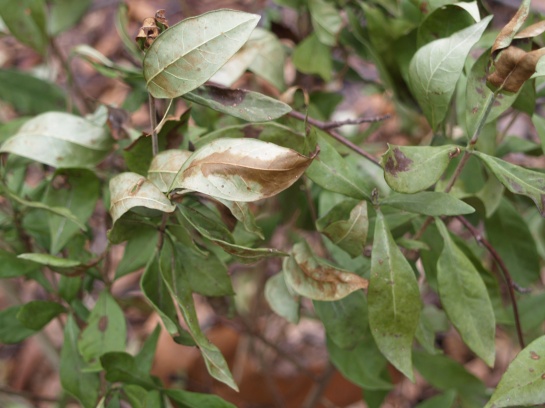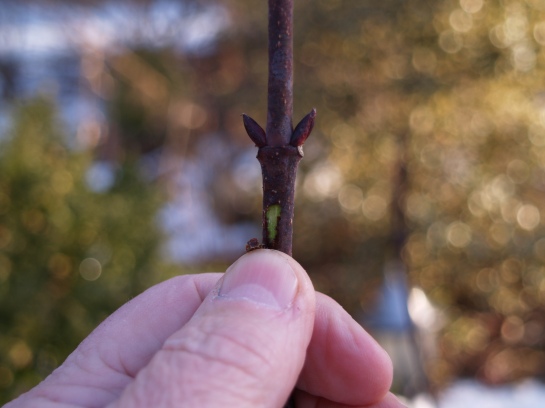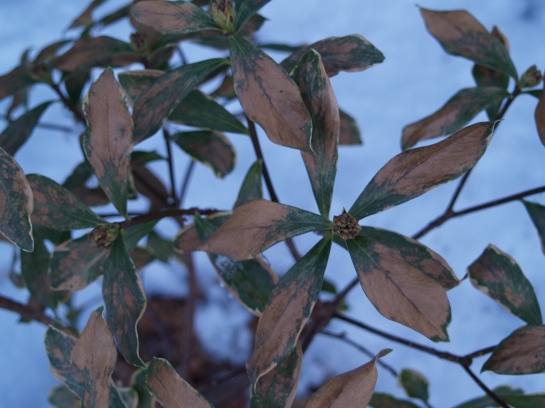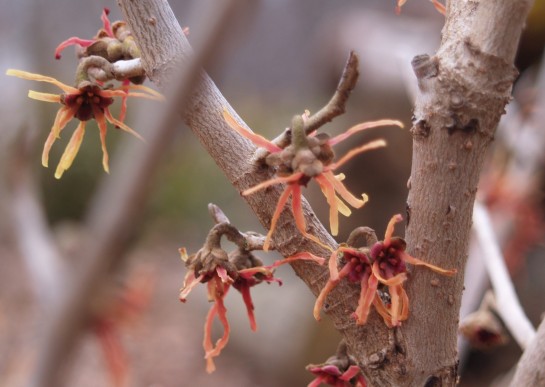At long last, this wearying winter is nearing its end, but not before leaving a trail of broken limbs and browned foliage. Ice and heavy snow (and snow again) have snapped branches and even entire trees, but as late winter creeps into spring the pressing issue is figuring what is alive from branches or entire plants that are destined for the compost heap. The primary concerns are evergreens with leaves or needles that are partially or entirely brown, and how can we differentiate the living from the dead? What plants can be salvaged, and what can be done to rejuvenate them this spring?
In some instances there is no quick or simple answer. There will be plants that are best left alone until spring growth (or the lack of) determines what is alive or dead, but we can fairly easily check the viability of branches to make an initial determination. Evergreens with foliage that is completely brown might be alive and well worth salvaging, and even a few shrubs that are dead to the ground can rejuvenate from live roots. The first step is to determine if branches are alive, and this will direct us to the next steps.

The scratch test
The health of many plants can be determined by simply scratching the bark of branches with a fingernail or a knife. Most often, green wood means that a plant is alive, regardless of the state of the foliage, and in most cases plants with live stems will force new growth in the spring to replace browned foliage. Shrubs such as nandinas (Nandina domestica, below) are classified as semi-evergreen, and these routinely turn brown and drop leaves in a cold winter. Even though temperatures were colder than average this winter, the lows were not extreme, and there is no reason to expect that nandinas will suffer any long term damage. New growth in April will replace the dead and browned leaves, and several weeks later there will be no evidence of winter injury. No pruning should be necessary to return nandinas and similar shrubs to good health this spring.
In the photo (below), there is no evidence of green foliage or wood on branches of this ‘Purple Diamond’ loropetalum (Loropetalum chinensis ‘Purple Diamond’). Branch tips were scratched first, and as brown wood was discovered I progressed further to the interior branches. Even if roots are alive it is unlikely that this marginally cold hardy shrub will grow sufficiently to revive within the next few years. I expect that the loropetalum is dead, but in my garden, only a few marginal shrubs appear to have died, including several varieties of gardenia (Gardenia augusta) and loropetalum that were well established through recent mild winters. I figure that I’ll have no choice but to remove these in the coming weeks, and I’ll decide later whether to gamble on replanting the same varieties.
 In the next photo (above) a woody shrub has been scratched to reveal green wood. I’ve checked several varieties of daphne (Daphne odora , below, and Daphne x burkwoodi ‘Carol Mackie’), and green under the bark confirms that these shrubs are likely to be fine once new growth commences. It remains questionable whether the daphnes will flower as usual (I suspect they will not), but I’m confident they will survive. I’ve seen the same situation with Southern magnolias (Magnolia grandiflora), Gordlinia (Gordlinia grandiflora), Camellias, and a few hollies (Ilex spp). Each has brown leaves, but live bark, so I expect no long term problem.
In the next photo (above) a woody shrub has been scratched to reveal green wood. I’ve checked several varieties of daphne (Daphne odora , below, and Daphne x burkwoodi ‘Carol Mackie’), and green under the bark confirms that these shrubs are likely to be fine once new growth commences. It remains questionable whether the daphnes will flower as usual (I suspect they will not), but I’m confident they will survive. I’ve seen the same situation with Southern magnolias (Magnolia grandiflora), Gordlinia (Gordlinia grandiflora), Camellias, and a few hollies (Ilex spp). Each has brown leaves, but live bark, so I expect no long term problem.
Dead branch tips
After scratching branches of several shrubs, I’ve determined that the body of the plant is green, but some branch tips are dead. This isn’t unusual, and the remedy is fairly simple. I typically wait until new growth sprouts, and then I prune dead wood back to the point of the first green leaves. Some shrubs, such as Beautyberry (Callicarpa), Blue Mist shrub (Caryopteris) and Butterfly bush (Buddleia) experience this annually, whether temperatures are above average or below.
Branch tips on soft wooded mophead hydrangeas (Hydrangea macrophylla) regularly die back in cold winters, and depending on the variety they might still flower normally in late spring. Older varieties (such as the popular ‘Nikko Blue’) flower on last year’s growth, so if the branch tips die and are pruned, this year’s flower buds are also removed. Recent introductions such as Endless Summer flower on both old and new wood, so these will flower as usual, although perhaps a week later.
What to do
In many cases, the best action will be to do nothing at all until the answers are more clear. Brown leaves will fall off, and new growth will happen in late March or April. Occasionally, crapemyrtles (Lagerstroemia) will not leaf out until early May, but for most trees and shrubs we’ll have a clear picture whether they’re alive or dead in the next six weeks.
If you confirm by scratching bark that branches are dead, there’s no need to wait for spring growth. Prune back to the nearest live branch or lateral growth bud. In the case of gardenias or loropetalums (or other evergreens that were planted late in the autumn and have turned brown), if these are completely brown and scratched wood is dead there is probably no reason to prolong the agony. But, don’t give up on an evergreen just because its foliage is brown. Scratch the bark to make certain. Otherwise, you might be giving up on a plant that would be perfectly healthy a month later.
In fact, there will be much less damage to plants than many people expect. Temperatures were not far below our average lows, and even though the winter was much colder than any in recent memory, this should not be cause for plants to fail to survive. Perennials and deciduous shrubs and trees are unlikely to effected, and I expect that by mid spring there will be little evidence of this brutal winter.
Fertilize, or not?
There should be no reason to provide any extra care for winter damaged shrubs beyond pruning dead wood. If we experience a spring drought, watering will be helpful, but fertilizing should not be necessary. There should be adequate nutrient levels in most soils to support spring growth, and excess fertilizer can damage stressed plants. For plants that appear to be growing vigorously in the spring a mild dose of fertilizer is not likely to hurt, and a topdress of compost will rarely be a problem.
So, for now, sit back and don’t be too concerned by the brown leaves. In a few weeks more typical spring temperatures will return, and you’re likely to see swelling buds and new growth that will assure you that damage from the cold is far less than you expected.

I would not anything back until it warms up and you see signs of new growth. When I lived in Florida and we experienced cold damage, we were warned not to cut back the dead parts of plants because warm days would encourage new growth and, if we had more cold weather, the new growth would die.
In areas with extreme fluctuations in temperature pruning must be done very carefully in late summer into autumn, and in early spring so that growth is not stimulated. In colder areas, spring growth begins late enough that this is rarely a problem. Several times in recent years new growth of Japanese maples was damaged to varying degrees by late April freezes, but this was due to normal growth and not encouraged by pruning. Late winter dormant pruning is rarely a problem.
I agree about being careful not to cut back too early –
here in London, I’m hoping that the time has nearly come!
Enjoy your beautiful plants – I’m enjoying your blog!
Emma. 🙂
This morning the garden is covered again by snow, five inches so far, and it will continue snowing for a few more hours. Temperatures have dropped steadily through the morning, and lows tonight are expected to be below zero Fahrenheit. Yesterday was forty degrees warmer, and I was encouraged by swelling buds that spring might really happen, but now we’re headed in the wrong direction.
Oh dear, Dave –
I’m sure things will turn around for you soon and the weather will be heading warmly in the ‘right direction’!!
Emma.
This was very helpful. Here in central Piedmont, NC, the cold has browned a lot of my shrubs. Two of five Gardenia augusta look pretty far gone. I’ll use your advice to test them.
I’ve read that January was the fourth warmest for the planet on record, but for the eastern half of the US this is the coldest winter in a few decades. Once spring arrives, decisions must be made whether to remove and replace marginally cold hardy shrubs such as gardenias, or to plant more cold hardy plants. With snow and falling temperatures, today is not a good day to make this decision, but I think that in the end we’ll decide that this winter was the anomaly.
Thanks for the advice Dave. Re: to fertilize or not, when is it best to apply Hollytone to holly trees typically? Am I understanding you correctly that should be skipped this spring this the trees might be stressed due to the very cold/long winter? Thanks!
In the mid Atlantic area there is no problem with fertilizing evergreens such as hollies in March. An established holly with some brown leaves should not be a problem, but I would go easy on a holly that was planted late last year that has more brown. Most of the winter damage will be superficial, and plants will grow out of it quickly.